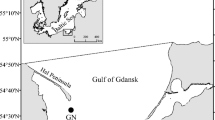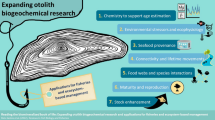Abstract
This study was done to determine the relative effects of five variables (sex, soft tissue dry weight, condition index, width∶height ratio, chronological age) on the concentrations of 24 elements in the blue musselMytilus edulis and to develop an improved protocol for collecting mussels for biological monitoring programs. The five explanatory variables were treated as independent variables in a multiple regression equation with the individual element concentrations being included as the dependent variable. A multivariate test was also performed. An initial test showed that chronological ageper se had no significant effect on the concentrations of any of the elements; therefore, it was dropped from the equation. Condition index and soft tissue dry weight showed a high degree of negative association with element concentrations. This was explained as being due to growth rate differences (dilution effect). An improved condition index is suggested. Sex was also a major factor in determining element concentrations with the greatest effects being noted for manganese, copper, arsenic, and selenium (females greater than males). The width∶height ratio showed a lesser but significant positive effect on element concentrations which was also considered to be due to growth rate differences (dilution effect). It is recommended that mussels only be collected from sites with similar maximum shell lengths. To ensure similar growth rates, all mussels from all sites should be of similar shell length and approximately 70–90% of the maximum potential length observed at the particular site where collected. Preexamination of mussels at each site should be done to ensure that the average condition index and width:height ratio (shell shape) of the mussels to be collected are similar. It is preferable to collect mussels subtidally, if available, during the late winter before significant spawning activity. Separate composite samples of male versus female mussels should be analyzed. When the above protocol is not feasible, an alternate statistical method is suggested which will enhance the interpretability of the results.
Similar content being viewed by others
References
Beauchemin D, McLaren JW, Willie SN, Berma SS (1988) Determination of trace metals in marine biological reference materials by inductively coupled plasma mass spectrometry. Anal Chem 60:687–691
Eisler R (1981) Trace metal concentrations in marine organisms. Pergamon Press, NY
Folsom TR, Young DR, Johnson JN, Pillai KC (1963) Manganese-54 and zinc-65 in coastal organisms of California. Nature 200:327–329
Gabbot PA (1976) Energy metabolism. In: Marine mussels: Their ecology and physiology. Bayne BL (ed). International Biological Programme 10. Cambridge University Press, Cambridge
Goldberg, ED (1976) The health of the oceans. The UNESCO Press, Paris
Lobel PB, Belkhode SP, Jackson SE, Longerich HP (1989) A universal method for quantifying and comparing the residual variability of element concentrations in biological tissue using 25 elements in the musselMytilus edulis as a model. Mar Biol 102:513–518
—, —, —, — (1990) Recent taxonomic discoveries concerning the musselMytilus: implications for biomonitoring. Arch Environ Contam Toxicol 19:508–512
—, —, —, — (1991a) A major factor contributing to the high degree of unexplained variability of some element concentrations in biological tissue: 27 elements in 5 organs of the musselMytilus as a model. Arch Environ Contam Toxicol 21:118–125
Lobel PB, Belkhode SP, Bajdik C, Jackson SE, Longerich HP (1991b) General characteristics of the frequency distributions of element concentrations and of interelemental correlations in aquatic organisms. (submitted manuscript)
Lobel PB, Belkhode SP, Jackson SE, Longerich HP (1991c) Sediment in the intestinal tract: A potentially serious source of error in aquatic biological monitoring programs. Mar Environ Sci (in press)
Lobel PB, Wright DA (1982). Total body zinc concentration and allometric growth ratios inMytilus edulis collected from different shore levels. Mar Biol 66:231–236.
Lutz, RA (1976) Annual growth patterns in the inner shell layer ofMytilus edulis L. J Mar Biol Assoc UK 56:723–731
Olivares JA (1988) Inductively coupled plasma-mass spectrometry. In: Methods in enzymology, Vol 158 Metallobiochemistry, Part A. Academic Press, San Diego, CA, pp 205–221
Phillips, DJH (1988) Use of macroalgae and invertebrates as monitors of metal levels in estuaries and coastal waters. In: Heavy metals in the marine environment. Furness RW, Rainbow PS (eds). CRC Press Inc., Boca Raton, FL
— (1980) Quantitative aquatic biological indicators. Applied Science Publishers, London
Seed (1968) Factors influencing shell shape inMytilus edulis L. Journal of the Marine Biological Association of the United Kingdom 48:561–584
— (1973) Absolute and allometric growth in the musselMytilus edulis L. (Mollusca: Bivalvia). Proceedings of the Malacological Society of London 40:343–357
Simpson RD (1979) Uptake and loss of zinc and lead by mussels (Mytilus edulis) and relationships with body weight and reproductive cycle. Mar Pollut Bull 10:74–78
Author information
Authors and Affiliations
Additional information
OSC Contribution Number 144
Rights and permissions
About this article
Cite this article
Lobel, P.B., Bajdik, C.D., Belkhode, S.P. et al. Improved protocol for collecting mussel watch specimens taking into account sex, size, condition, shell shape, and chronological age. Arch. Environ. Contam. Toxicol. 21, 409–414 (1991). https://doi.org/10.1007/BF01060364
Received:
Issue Date:
DOI: https://doi.org/10.1007/BF01060364




